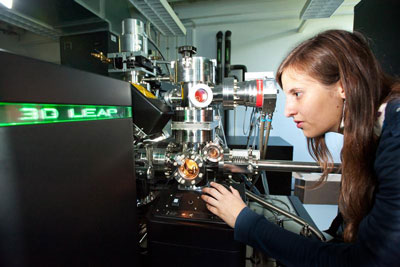| Sep 02, 2013 |
European material researchers present new materials and offer a look inside matter
|
|
(Nanowerk News) When the wing of an aircraft "feels" a threatening load or metal foams become as lightweight and solid as our bones, you know materials scientists had their fingers in the pie. They search for perfect models in nature in order to give materials new capabilities. With the help of microscopy and tomography they constantly develop more precise analysis methods to look deep inside materials. They can thus better understand their structure in order to develop customised materials for the industrial, medical and energy sectors. Scientists will discuss the latest trends from September 8 to 13 at the largest European conference on materials research in Seville (EUROMAT 2013). Professor Frank Mücklich of Saarland University is the scientific director of the conference.
|
|
About 70 per cent of all German exports in the global market rely solely on the use of innovative materials. This is what a study by the German Academy of Science and Engineering has shown. "Materials research is of enormous importance for European competitiveness", says Frank Mücklich, Functional Materials Professor at Saarland University. He is this year’s scientific director for Europe’s largest conference on materials research, Euromat, taking place in Seville. Some 2500 scientists from all over Europe, USA, Asia, Latin America and Australia will be showcasing their latest research.
|
 |
| The Atom Probe Tomography makes it possible to look into the very heart of materials and determine the spatial positioning of atoms.
|
|
Materials research today covers a wide range of applications. The automotive industry, for example, requires strong yet light materials for car bodies and engines. They are also interested in new materials for sensors and controllers, especially for high-end automobiles. "Electromobility, however, requires materials that can store energy or ensure a stable power distribution with minimum losses. Medical technology in turn needs tiny sensors that can supply their own electricity, for example, through small temperature differences", explains Mücklich.
|
|
The Saarbrücken professor identifies several trends that scientists all over Europe are involved in. "Until very recently, materials were increasingly complex and made of a combination of many raw materials. Yet these are becoming more and more scarce, some very expensive, so we now focus on solutions that can be implemented with few materials. These can exhibit very different properties thanks to tailored microstructures. One example is carbon-based materials such as nanotubes, which are extremely strong from a mechanical point of view, but also offer a high electrical conductivity", explains Frank Mücklich. Many material researchers also turn to models from nature that over the course of evolution have developed effective systems, often with very few chemical elements.
|
|
The scientist sees another trend in the development of intelligent autonomous systems which supply themselves with energy. Such systems, for example, can "feel" supported loads and send correction signals to the system. They are used in so-called "domotics" for home energy management and monitoring. Materials research has received a big boost in recent years primarily due to new analytical methods. "We can now accurately analyse all materials not only chemically, but also illustrate the lattice structure of the crystals and show which atoms are present at which point in the material. These nanostructures can be simulated and modelled in 2D and 3D", explains Professor Mücklich. These findings allow for a first-ever complete understanding of existing materials. This helps to improve conventional materials and to develop new ones, where properties can be combined that were previously incompatible.
|
|
Materials Science and Engineering at the Saarland University campus with its about 300 scientists is one of five nationwide leading locations in this area. The current 13 professorships at the University are closely linked with the researchers at the Leibniz Institute for New Materials and the Fraunhofer Institute for Nondestructive Testing. Several Saarbrücken scientists will present their latest research findings in early September at the biggest European materials research meeting, in Seville.
|

